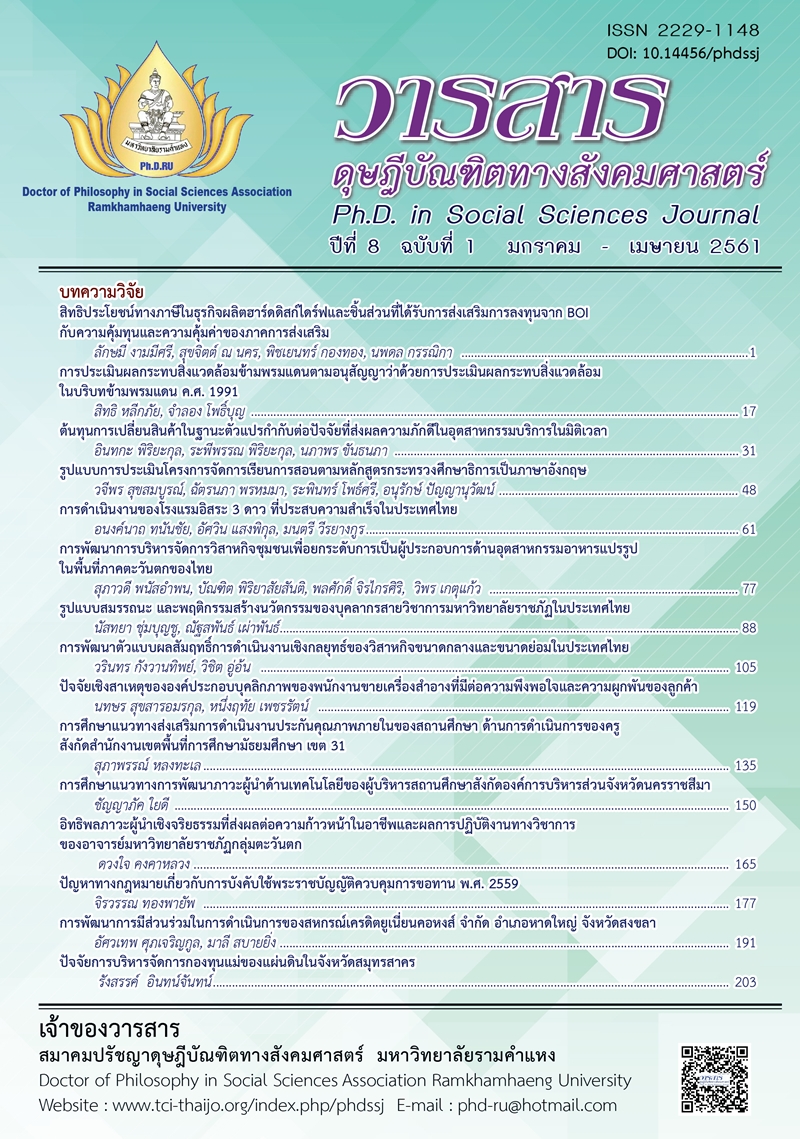CASUAL FACTORS OF PERSONALITY ELEMENT OF COSMETIC SALESPERSON: TOWARD CUSTOMER SATISFACTION AND CUSTOMER ENGAGEMENT
Main Article Content
Abstract
This research was the quantitative research had the aim as follow; (1). To study casual factors of personality element of cosmetic salesperson affecting customer’s satisfaction and customer’s engagement (2) To study the effect of casual factors of personality element of cosmetic salesperson affecting customer’s satisfaction and customer’s engagement. Researcher reviews related theories and literature determinant personality element variables before established assumption and collected data from sampling group from 335 customers who purchase cosmetic product with salesperson in 8 department stores in Bangkok before analyzed by Structural Equation Model--SEM)
Research found that customer satisfaction (CTS) has influenced directly by the salesperson characteristic (SPC), salesperson communication tool (SPT) and salesperson’s knowledge (SPK). The direct effect sizes were 0.99, 0.69 and 0.65, respectively, by statistically significant at 0.01 and 0.05. The customer engagement (CTE) has influenced directly by the customer satisfaction (CTS) effect sizes was 0.45 by statistically significant at 0.01. In addition, customer engagement (CTE) also influenced directly by the salesperson characteristic (SPC), salesperson communication tool (SPT) and salesperson’s knowledge (SPK) effect sizes were 0.17, 0.31 and 0.07 and also indirect effect through the customer satisfaction (CTS) were 0.45, 0.01 and 0.29, respectively, by the significant 0.01 and 0.05.
Article Details
Academic articles, research articles, and book reviews in the Ph.D. in Social Sciences Journal are author’s opinions, and not the publisher’s, and is not the responsibility of the Ph.D. in Social Sciences Journal Philosophy Association, Ramkhamhaeng University. (In the case that research is done on human, the researcher has to be trained in Ethics for Doing Research on Human Training and has to produce the evidence of the training).
References
Angsuchoti, S., Wijitwanna, S., & Pinyopanuwat, R. (2011). Apply statistics for social science and behavioral science: Using technique of LISREL. Bangkok: Charoendi Mankhongkanphim. [In Thai]
Cambra-Fierro, J., Melero-Polo, I., & Vázquez-Carrasco, R. (2014). The role of frontline employees in customer engagement. Revista Española de Investigación en Marketing ESIC, 18(2), 67-77.
Castillo, J. (2017). The relationship between big five personality traits, customer empowerment and customer satisfaction in the retail industry. Journal of Business and Retail Management Research (JBRMR), 11(2), 11-29.
Chaubey, P. D. D. S., Tripathi, N., & Tripathi, D. D. M. (2016). Exploration of safety concerns in purchase behaviour for cosmetics products. International Journal of Engineering and Management Research, 6(4), 371-379.
Hammerich, W. (2015). The role of personality and organisational cultural differences in the success of salesperson-buyer dyads. Johannesburg, South Africa: University of Witwatersrand, Faculty of Commerce Law and Management.
Lawrence, L. G. Jr., Earl D. H. Jr., & Dotson, M. .J. (2015). The use of personal appearance cues to infer sales rep character. International Journal of Management Practice, 8(1), 1-20.
Lee, D. (1993). Developing effective communications. Retrieved May 15, 2016, from https://extension. missouri.edu/publications/DisplayPrinterFriendlyPub. aspx
McColl, R., & Truong, Y. (2013). The effects of facial attractiveness and gender on customer evaluations during a web-video sales encounter. Journal of Personal Selling & Sales Management, 33(1), 117-128.
McCrae, R. R., & Costa, P. T. (1989). Reinterpreting the Myers Briggs type indicator from the perspective of the five factor model of personality. Journal of personality, 57(1), 17-40.
Ministry of Commerce. (2016). Import of Thai products. Retrieved March 2, 2016, from https://www.ops3.moc.go.th/import/recode_import_rank/report.asp [In Thai]
Missaoui, Y. (2015). Non-verbal communication barriers when dealing with Saudi sellers. International Journal of Organizational Leadership, 4(4), 392-402.
Pinsuwan, S. (2012). Qualifications of sales assistants affecting satisfaction of their service quality among working women in Bangkok: A case study of Payot brand. Master's thesis business administration, Bangkok University. [In Thai]
Sashi, C. (2012).Customer engagement, buyer-seller relationships, and social media. Management Decision, 50(2), 253-272.
Tabasum, M. I., Rabbani, M., & Muhammad Asif, F. (2015). Impact of salesmen personality on customer perception and sales. Global Journal of Management And Business Research, 14(8), 62-68.
Williams, K. C., & Spiro, R. L. (1985). Communication style in the salesperson-customer dyad. Journal of marketing Research, 22(4), 434-442.
Wiratchai, N. (1999). LISRELL model: Statistical analysis for research (3rd ed.). Bangkok: Chulalongkorn University Press. [In Thai]
Zboja, J. J., Clark, R. A., & Haytko, D. L. (2016). An offer you can’t refuse: Consumer perceptions of sales pressure. Journal of the Academy of Marketing Science, 44(6), 806-821.
Zikmund, W. G. (2010). Business research methods (8th ed.). New York: John Wiley & Sons.


